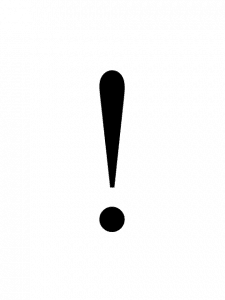 It isn’t easy to grasp the concept of when to use exclamation marks, especially in today’s world where they seem to be more common than Charlie Sheen’s trips to his local liquor store.
It isn’t easy to grasp the concept of when to use exclamation marks, especially in today’s world where they seem to be more common than Charlie Sheen’s trips to his local liquor store.
Some people think that they add flare and expression to writing, while others detest them, claiming that exclamation marks serve no real purpose and should be eradicated from English punctuation for good.
Here’s our view on the exclamation mark and when it should, and should not, be used.
The Exclamation Mark
The exclamation mark, or exclamation point, is a punctuation mark that is placed after a word or at the end of a sentence in order to emphasize strong feelings or to indicate abrupt shouting or interjections. For example: “Hey!”, “Stop right there!” Alternatively, the exclamation point can accompany mimetically produced sounds. For example: “The dog went woof! as the postman passed the gate.”
In more recent times, the exclamation mark has become increasingly overused and many people have developed the habit of using more than one exclamation mark to try and increase the effect of the punctuation. For example: “Laugh out loud!!!! You rock!!!”
This type of usage gets on the nerves of many grammarians and English academics alike and it really is best to avoid it at all costs in any type of formal writing.
For more information about the exclamation mark, see our article: 14 punctuation marks.
When to use exclamation marks
Academic and Formal Writing
It is generally accepted that the exclamation mark should not be used within academic or formal writing. Grammarians and linguists argue that the exclamation mark has no place in this type of writing because they believe that an adept writer should be capable of emphasizing a point without the need for an exclamation mark. They view the usage of exclamation points as immature and colloquial. For this reason, it is best to avoid the use of exclamation marks when editing cover letters, business writing, resumes, job applications and academic writing, unless you are directly quoting a sentence or extract that does use an exclamation mark.
Creative Writing
Writers are more open to take liberties with punctuation rules when composing creative documents because this type of communication is much more artistic and imaginative. However, even though the use of exclamation marks is more acceptable in this genre, it is crucial that they are not overused, as this can make the writer appear lazy and incapable of effectively using language to convey emotion and passion. If you do want to use exclamation marks, use them sparingly and never use more than one after a sentence or word.
Social communication
The popularity of social networks and computer-based communication methods in recent years has given rise to a whole new written form of English, within which the exclamation mark features heavily. It is not unusual for text messages to feature strings of exclamation marks, with the general rule of thumb being the more exclamation marks that are used, the higher the degree of emphasis.
In informal forms of writing such as email, text messages, Facebook wall posts, chat room exchanges, and Twitter updates, the use of the exclamation mark is completely acceptable—almost compulsory. However, the key to ensuring appropriate use of this punctuation mark within social communication vehicles is to bear in mind the recipient of the message. What is a suitable response to a friend’s email, may be highly inappropriate for an email sent to a professor or in a SMS response to a text-based reminder of a pending job interview.
If you’re still not sure about when to use exclamation marks, or any other type of punctuation mark, then our online proofreading services can help.
